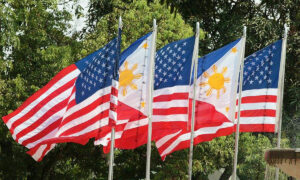THE PHILIPPINES’ reciprocal trade agreement with the US is still being finalized a day before its expected implementation, the Department of Trade and Industry (DTI) said.
“Our talks are still ongoing. We just have to see what will happen on Aug. 1,” said Trade Undersecretary Allan B. Gepty on the sidelines of the British Chamber of Commerce Philippines 2025 Midyear Economic Briefing.
“The announcement is 19% but let us see what will happen. There are still a lot of things that we are ironing out,” he added.
The US is expected to implement the 19% tariff on Philippine goods starting today (Aug. 1), slightly lower than the 20% rate that US President Donald J. Trump threatened to impose.
While this is the second-lowest rate in Southeast Asia, the rate is still higher than the 17% announced in April.
Philippine government officials have justified the modest tariff shift to the few concessions it had offered. The Philippines had agreed to grant zero tariffs on automobiles, wheat, soy, medical equipment, and pharmaceutical products from the US.
“Well, maybe what I can say is that we are working on the details. So, the details, of course, cover other terms and conditions of the agreement because it’s not just market access,” said Mr. Gepty.
“So, there is a set of rules that we are negotiating. But of course, as I have mentioned before, it is covered by our nondisclosure agreement,” he added.
Citing previous US pronouncements, Mr. Gepty said that Washington is also interested in a lot of measures that basically affect trade.
“So, that is why we also have to address those measures, like the nontariff barriers,” he said. “Definitely there will be some announcements to be made once there is a set of parameters that will be agreed upon by both sides.”
“What is really important is that we engage with the US. Because the US is a major trading and investment partner of the country. And of course, we’re really advocating for a free trade agreement (FTA),” he added.
LIMITED IMPACTMeanwhile, Finance Undersecretary and Chief Economist Domini S. Velasquez said the impact of the US tariff on the Philippine economy will likely be “very limited.”
“It’s not just the Philippines, but we compare it with others. Until we have that kind of clarity, we don’t know. We know it’s limited given that we have smaller exports compared to the rest of the world,” she told reporters on the sidelines of an event on Thursday.
“(For) full-year GDP, (the impact is) very limited. For exports, of course, it will have an impact… but we need to see the whole picture,” she added.
The Philippines’ new US tariff rate is now the same as Indonesia, and slightly lower than Vietnam’s 20%.
“For the Philippines, we do think it is still one of the lowest in the region at 19%… for example, semiconductors, which take up a majority of the exports of the Philippines, remain to be zero tariffs or exempt for now.”
“Looking at our domestic situation, the Philippine economy continues to grow at a solid pace, broadly aligned with the 6% target of the government,” she added.
The government is targeting 5.5-6.5% growth this year. The Philippine Statistics Authority is set to release second-quarter GDP data on Aug. 7.
Ms. Velasquez noted the recent trade deficit data, which showed a surge in exports, reflecting the frontloading done by US importers.
Latest data from the Philippine Statistics Authority (PSA) showed the country’s trade deficit narrowed to $3.95 billion in June as exports jumped by 26.1% to $7.02 billion. This marked the sixth straight month of annual expansion for exports.
In June, the United States was the top destination for Philippine-made goods at $1.22 billion or a 17.3% share to total exports.
“We’re a little bit more cautious in the second half of the year in terms of trade because imports in the US have increased. Exports, not just in the Philippines but in the rest of Asia, have increased also because of this front-loading of exports to the US,” Ms. Velasquez said.
Meanwhile, Ms. Velasquez said the government is continuing to implement reforms and policies that will further open up the economy and generate investor interest.
“There’s difficulty for foreign investors to come in here. Now that we’ve liberalized (several sectors), what we need to do is incentivize investors to come into the Philippines.”
“Unfortunately, it’s a very uncertain environment and it’s a little bit more difficult as opposed to your business-as-usual kind of environment,” she said.
The Corporate Recovery and Tax Incentives for Enterprises to Maximize Opportunities for Reinvigorating the Economy Act (CREATE MORE) is one such measure that the government is banking on to bring in more investors.
“This administration is building on past liberalization reforms by actively incentivizing foreign investment through the CREATE MORE Act,” she said.
The CREATE MORE Act has yielded a total of 182 projects with committed investments worth P90.13 billion since the approval of its implementing rules and regulations. It is also expected to generate more than 40,000 jobs. — Justine Irish D. Tabile and Luisa Maria Jacinta C. Jocson
